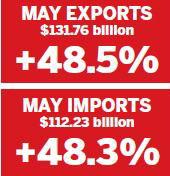BEIJING - Overseas shipments for May surged nearly 50 percent from a year earlier, which analysts said was a signal that the European sovereign debt crisis has had little impact on the nation's exports.
But many economists are cautious over long-term growth prospects despite the highest monthly rate of increase in six years.
Customs announced on Thursday that exports grew 48.5 percent to $131.76 billion in May, 18.1 percentage points higher than in April. Imports gained 48.3 percent to $112.23 billion and the trade surplus stood at $19.53 billion, more than 10 times the April figure.
Many economists had tipped export growth at 30 to 33 percent.

Exports to the US and EU rose by more than 44 and 50 percent, compared with 21 percent and 33 percent from January to April. Exports to the rest of Asia also grew strongly, with the figure for ASEAN rising 46.2 percent.
"China and other nations in Asia are more and more reliant on each other," said Lu Kejian, director general of Department of Asian Affairs of the Ministry of Commerce.
As uncertainties persist in the US and EU economies, "China's exports to Asian nations are growing bigger and bigger," he said.
On Wednesday, the International Monetary Fund warned that global economic risks have "risen significantly" with the European debt crisis still unresolved.
"The story here is strong headline export numbers for May. But the impact from the European crisis and concerns over sustainability of the US growth are yet to be seen. So we shouldn't get over-optimistic based on these numbers," said Yan Jinny, economist at Standard Chartered Shanghai.
Wang Xiaoguang, a senior researcher at the Chinese Academy of Governance, also cautioned against exuberance as a result of the latest figures.
"I cannot see any reasons that support strong, lasting growth, given that the global economic recovery is still fragile," he said.
But Wang admitted that the European debt crisis has so far not impacted the Chinese economy and trade much.
China's exports to the EU hit $236.2 billion last year, accounting for 20 percent of its total overseas shipments. But exports to the PIIGS nations (Portugal, Ireland, Italy, Greece, Spain), now mired in the debt crisis, were $41.7 billion, making up only 3.5 percent of the total.
Although the ratio is small, "it's too early to conclude the impact of the European crisis is limited as there is a possibility that the crisis will spread to many other European nations. Besides, the renminbi has gained a lot against the euro recently, putting Chinese exporters at a disadvantageous position," said Lian Ping, chief economist at Bank of Communications.
"Such growth cannot continue in the months ahead."
But many believe the trade deficit in March was an anomaly, and export growth will continue in the coming months.
In March, China posted its first monthly trade deficit in over five years. Since May last year, import growth outperformed exports, thanks to drop in export prices, strong domestic demand and rises in commodity prices.
"The export growth is stronger than it looks, and we have seen moderation in the price drop," said Sun Mingchun, economist at Nomura Global Economics.
During the first five months, machinery and electronics products maintained robust growth and the momentum is expected to continue. But experts worry that this will trigger a new round of trade protectionist measures against China.
US lawmakers are urging President Barack Obama to get tough against China, and have proposed a Senate vote on whether to label China a currency manipulator this month.
Since July 2008, Beijing has kept the yuan pegged to the greenback at about 6.83 after the Chinese currency gained 21 percent during the 2005-2008 period.
"We think China is set to announce reforms to its exchange rate regime, likely within weeks," said Sun.
But Chen Xingdong, chief China economist at BNP Paribas, noted the world should not harbor high expectations of currency revaluation.
"The chances of the nation making a substantial move are very slim," he said.
But he believes "China might abandon the peg to the US dollar for a managed float sometime around the G20 meeting (later this month)."





